Indoor Plant Fertilizer: When and How to Apply It Right
Indoor plant fertilizer is essential for replenishing nutrients that potted plants quickly deplete from the soil. It supports healthy growth, vibrant foliage, and flowering by supplying key elements like nitrogen, phosphorus, and potassium.
To apply indoor plant fertilizer correctly, use a diluted liquid formula or slow-release granules during active growing seasons—typically spring and summer. Always follow the label instructions and avoid over-fertilizing, which can damage roots and leaves.
Choosing the right indoor plant fertilizer and applying it at the right time helps your houseplants thrive year-round. Let’s explore how to do it step by step.
Table of Contents
Table of Contents
Why Indoor Plant Fertilizer Matters
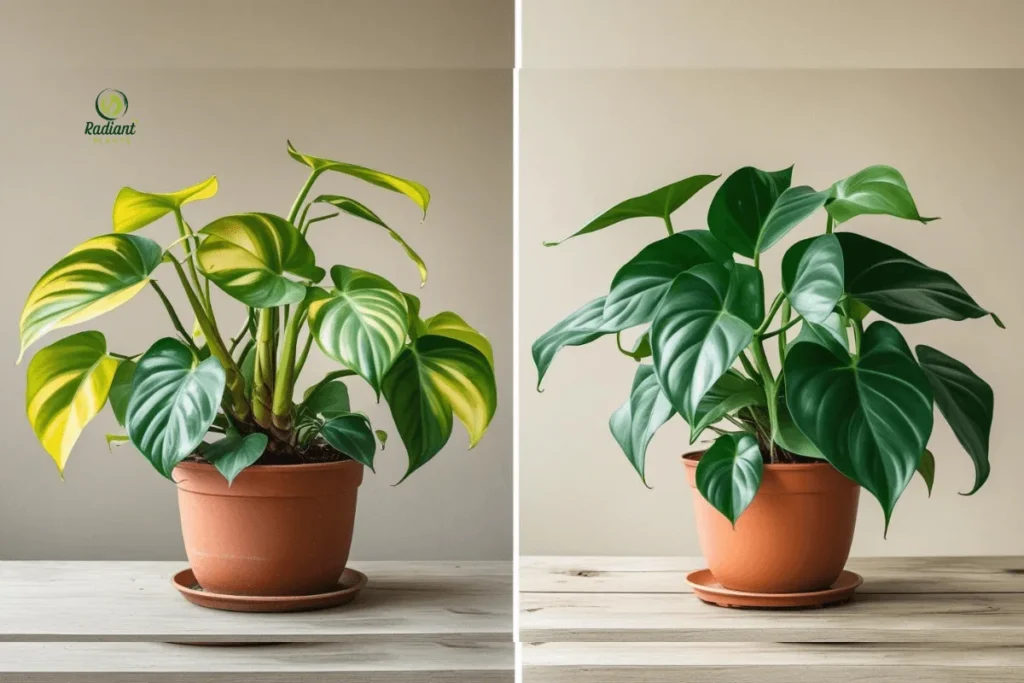
Nutrients Your Plants Can’t Live Without
Indoor plant fertilizer plays a critical role in keeping your houseplants healthy and growing strong. Since indoor plants are confined to pots, they can’t access natural sources of nutrients the way outdoor plants can. Over time, watering flushes nutrients out of the soil, making fertilizer the only way to replenish them.
The three primary nutrients in indoor plant fertilizer are:
- Nitrogen (N): Promotes lush, green foliage
- Phosphorus (P): Supports root development and blooming
- Potassium (K): Strengthens stems and boosts overall plant resilience
These are often listed as N-P-K on fertilizer labels. Without regular feeding, even the healthiest plant can become weak or stunted. That’s why understanding how and when to use indoor plant fertilizer is key to long-term plant success.
Signs Your Plants Need Fertilizing
🪴 Snippet-style summary:
If your indoor plants are showing pale leaves, weak growth, or fewer flowers, they may be lacking nutrients. These symptoms signal it’s time to fertilize.
Over time, nutrient deficiencies become visible, especially if you’re not using indoor plant fertilizer regularly. Here are the most common signs that your plants need feeding:
✅ Common Deficiency Symptoms:
- Yellowing leaves, especially older ones at the bottom
- Stunted growth or fewer new leaves
- Pale green or dull leaf color
- Brown leaf tips or crispy edges
- Lack of flowering in blooming varieties
- Weak stems or drooping despite proper watering
- Slow recovery after repotting or pruning
⚠️ Many of these signs can also be caused by overwatering or poor light. Always rule out environmental issues before increasing fertilizer.
Symptom | Possible Nutrient Deficiency | What to Do |
|---|---|---|
Yellow leaves | Nitrogen | Use balanced NPK fertilizer |
Poor flowering | Phosphorus | Choose bloom-boosting formula (higher P) |
Brown leaf tips | Potassium or salt buildup | Flush soil, use gentle fertilizer |
Dull leaf color | General nutrient loss | Feed with all-purpose liquid fertilizer |
Drooping, weak stems | Overall deficiency or low potassium | Flush the soil, use gentle fertilizer |
Indoor plant fertilizer helps reverse these issues and prevent them from recurring. For best results, feed your plants during their active growth periods and match the fertilizer type to the plant’s needs. Whether you choose liquid, granular, or spikes, consistency matters more than quantity.
Most plants benefit from fertilizing every 2–4 weeks in spring and summer, and less frequently or not at all in fall and winter. Always check the product label and err on the side of caution—more fertilizer is not always better.
When in doubt, start with a diluted dose of indoor plant fertilizer and observe how your plant responds over the next few weeks. A greener, perkier plant is a good sign you’re on the right track.
Types of Indoor Plant Fertilizer Explained
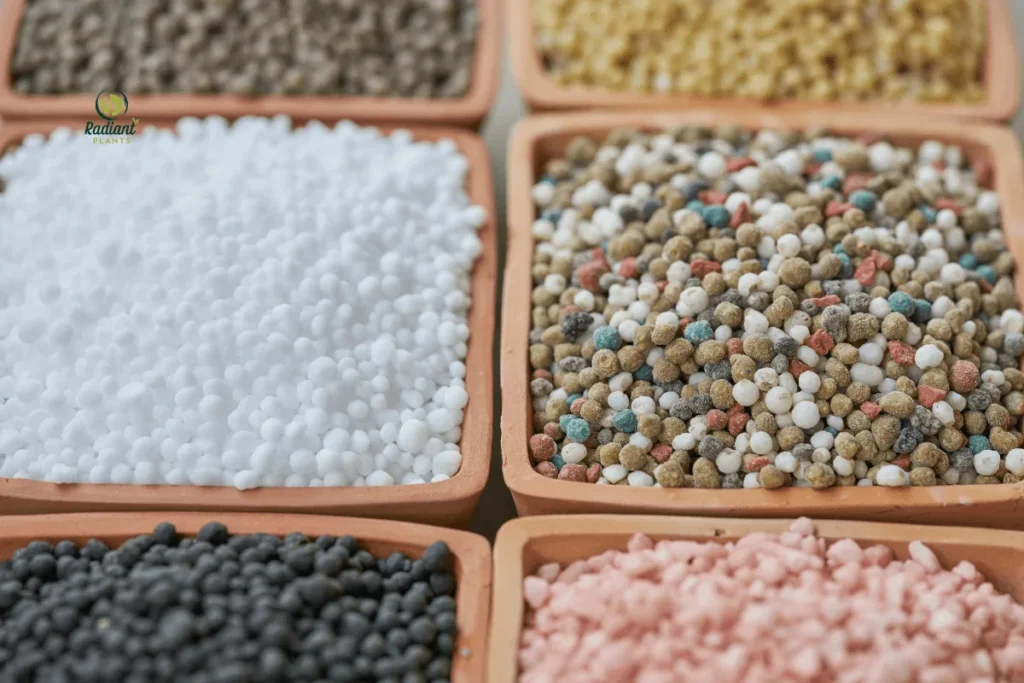
Liquid vs. Granular vs. Spikes
🪴 Snippet-style summary:
Indoor plant fertilizers come in liquid, granular, and spike forms. Each type has pros and cons depending on ease of use, nutrient delivery, and plant needs.
Choosing the right indoor plant fertilizer form is key to nourishing your houseplants effectively. While all forms aim to provide essential nutrients, how they deliver those nutrients—and how often—can vary significantly.
Let’s break down the most common forms:
🧪 Liquid Fertilizer
- How it works: Mixed with water and applied during regular watering
- Best for: Quick absorption, frequent feeders, delicate plants
- Pros: Easy to control dosage, fast results
- Cons: Requires frequent reapplication, easy to overdo
🟤 Granular Fertilizer
- How it works: Dry pellets mixed into soil release nutrients over time
- Best for: Medium- to large-sized potted plants
- Pros: Long-lasting, economical
- Cons: Harder to control exact release rate, may require mixing into the oil
📌 Fertilizer Spikes
- How it works: Pre-measured spikes are inserted into the soil
- Best for: Busy plant owners, low-maintenance feeding
- Pros: Convenient, mess-free
- Cons: Uneven nutrient distribution, slow effect, hard to adjust dosage
Organic vs. Synthetic Options
Indoor plant fertilizer can also be classified by source: organic or synthetic. While both can nourish your plants, they differ in origin and release rate.
🌿 Organic Fertilizer
- Made from: Natural materials like compost, bone meal, fish emulsion
- Benefits: Slow release, soil-friendly, eco-conscious
- Best for: Long-term health, sensitive plants, sustainability-focused growers
- Considerations: Has odor, slower results, may attract pests
⚗️ Synthetic Fertilizer
- Made from: Chemically manufactured nutrients
- Benefits: Fast-acting, predictable results, specific NPK ratios
- Best for: Immediate nutrient boosts, correcting deficiencies
- Considerations: Risk of salt buildup, environmental impact with overuse
📊 Table: Indoor Plant Fertilizer Types Compared
Type | Form | Ease of Use | Frequency | Pros | Cons |
|---|---|---|---|---|---|
Liquid | Liquid | Easy | Every 1–2 weeks | Fast absorption, easy to dilute | Needs frequent use, can overfertilize |
Granular | Dry Pellets | Moderate | Every 1–2 months | Long-lasting, affordable | Harder to control release |
Spikes | Solid Sticks | Very easy | Every 1–2 months | Mess-free, pre-measured | Uneven distribution, slow to act |
Organic | Varies | Moderate | Every 4–6 weeks | Eco-friendly, improves soil quality | Slower results, possible smell |
Synthetic | Varies | Easy | 2–4 weeks | Fast results, customizable nutrients | May cause salt buildup, less eco-safe |
Caption: Indoor Plant Fertilizer Types Compared
When choosing an indoor plant fertilizer, consider your lifestyle, your plant’s needs, and how hands-on you want to be. If you enjoy routine care and fast results, liquid may suit you best. For more passive feeding, spikes or granular types may be a better fit.
Ultimately, the best approach may be a combination—using a slow-release base (like granular or organic) with occasional liquid boosts during high-growth months. Regardless of the form, always follow instructions to avoid nutrient burn or imbalances.
When to Fertilize Indoor Plants

🪴 Snippet-style summary:
Most indoor plants benefit from fertilizer during spring and summer when they’re actively growing. Use the right indoor plant fertilizer based on the season and plant type.
Using indoor plant fertilizer at the right time is just as important as choosing the right type. Feeding too early, too late, or too often can lead to weak growth, burned roots, or nutrient imbalance. To keep your houseplants healthy and happy, it’s essential to match your fertilizing schedule with the plant’s natural growth cycle.
Seasonal Timing (Spring, Summer, Fall, Winter)
Most houseplants follow seasonal growth patterns—even indoors. Here’s how your fertilizing routine should align with the seasons:
- 🌱 Spring: Start feeding when new growth appears. This is the beginning of the plant’s active season.
- 🌞 Summer: Continue regular feeding every 2–4 weeks using a balanced indoor plant fertilizer.
- 🍂 Fall: Gradually reduce fertilizing as daylight decreases and growth slows.
- ❄️ Winter: Most indoor plants go dormant or slow their growth. Stop fertilizing or apply only once during this period if necessary.
⚠️ Fertilizing during dormancy can harm roots or lead to salt buildup in soil. Always observe your plant’s behavior before feeding.
Frequency Based on Plant Type
Not all plants need the same level of feeding. Here’s a breakdown by type to help guide your routine:
- 🌿 Foliage Plants (e.g., pothos, ferns, peace lilies):
Every 2–4 weeks in spring/summer with a nitrogen-rich formula - 🌸 Flowering Plants (e.g., African violets, orchids):
Every 1–3 weeks with a bloom-boosting fertilizer (higher phosphorus) - 🌵 Succulents & Cacti:
Once a month or less, using a diluted, low-nitrogen mix - 🌴 Palms & Dracaena:
Every 4–6 weeks, using a balanced, slow-release fertilizer
📆 Monthly Fertilizing Schedule by Plant Type
Plant Type | Spring | Summer | Fall | Winter |
|---|---|---|---|---|
Foliage Plants | Every 2–3 weeks | Every 2–4 weeks | Once monthly | None |
Flowering Plants | Every 1–2 weeks | Weekly | Every 2–4 weeks | Rarely (if blooming) |
Succulents & Cacti | Monthly | Every 4–6 weeks | Once (optional) | None |
Orchids | Every 2 weeks | Weekly | Every 3–4 weeks | Pause or once max |
Palms & Large Tropicals | Every 4 weeks | Every 4 weeks | Once monthly | None |
Tip: Always water the plant before applying indoor plant fertilizer to avoid root burn.
❓ FAQ Box
Can you fertilize plants in winter?
Most indoor plants do not need fertilizer in winter. Growth slows or stops, so feeding during this time can lead to root damage or nutrient buildup. Only continue fertilizing if the plant is actively growing under grow lights or controlled conditions.
Is over-fertilizing worse than under-fertilizing?
Yes. Over-fertilizing can cause salt buildup, leaf burn, and root damage. Under-fertilizing may slow growth, but it’s usually safer and easier to correct. When in doubt, dilute the fertilizer or apply less frequently.
Using indoor plant fertilizer effectively means understanding both the calendar and your specific plant’s behavior. Always watch for signs like new leaves or blooms to time your feedings just right.
How to Apply Indoor Plant Fertilizer Correctly
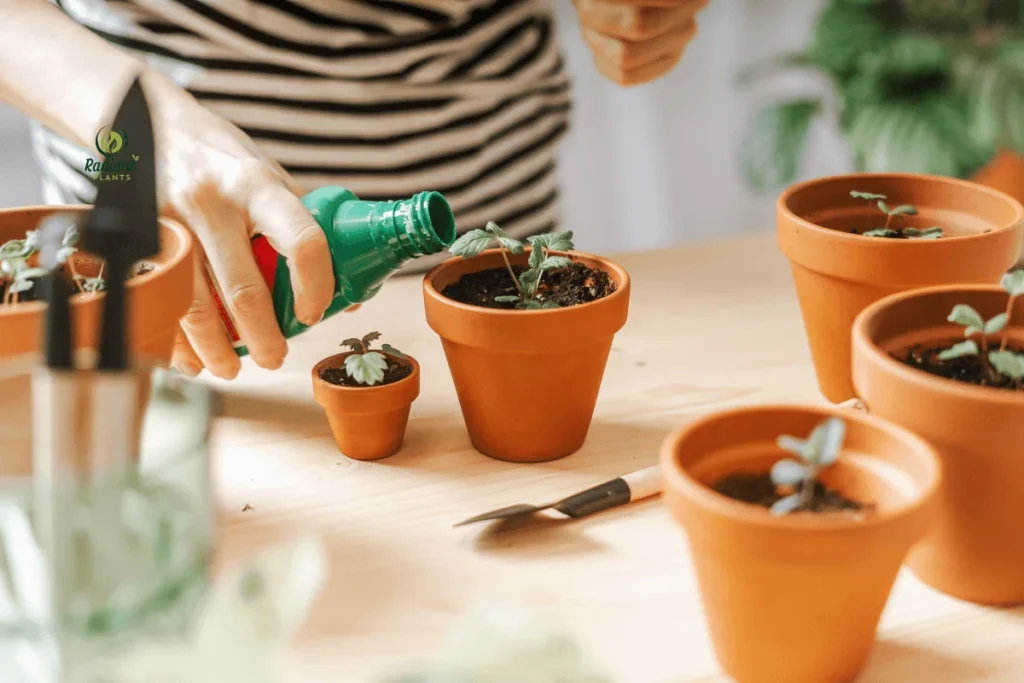
🪴 Snippet-style summary:
To apply indoor plant fertilizer correctly, match the method to the fertilizer type—liquid, granular, or spikes—and always follow label instructions carefully.
Applying indoor plant fertilizer the right way ensures your houseplants get the nutrients they need, without the risk of overfeeding or damage. Whether you’re using a liquid blend, slow-release granules, or pre-measured spikes, each type requires a specific method to be most effective.
The goal is to nourish your plants gently and consistently while avoiding buildup or root stress. Below is a simple breakdown for applying each fertilizer type.
Step-by-Step Application Process
✅ Instructions for Liquid, Granular, and Spike Application
🌊 Liquid Fertilizer
- Step 1: Dilute the fertilizer according to the label (usually ½ to 1 cap per gallon of water)
- Step 2: Water your plant lightly with plain water first to moisten the soil
- Step 3: Apply the diluted fertilizer during your regular watering
- Step 4: Pour evenly around the base, avoiding leaves
- Step 5: Repeat every 1–2 weeks in the growing season
🟫 Granular Fertilizer
- Step 1: Measure the recommended amount based on pot size (typically a few tablespoons)
- Step 2: Sprinkle evenly on top of moist soil or gently mix into the top inch
- Step 3: Water the plant after applying to help activate the release
- Step 4: Reapply every 4–6 weeks, depending on the formula
📌 Fertilizer Spikes
- Step 1: Check the packaging for how many spikes are needed based on the pot size
- Step 2: Push the spike 1–2 inches into the soil near the plant edge
- Step 3: Water as usual—no need to remove the spike
- Step 4: Replace every 30–60 days as directed
💡 Tip: Regardless of type, apply indoor plant fertilizer in the morning so plants have all day to absorb nutrients in light and warmth.
Common Mistakes to Avoid
✅ Watch out for these frequent fertilizing errors
Misusing indoor plant fertilizer can cause more harm than good. Many beginners unintentionally damage their plants by feeding too often or choosing the wrong formula.
Here are the most common mistakes to avoid:
- ❌ Overfeeding: Too much fertilizer leads to leaf burn, salt buildup, or root damage. More isn’t better—stick to a schedule.
- ❌ Fertilizing Dry Soil: Always water your plant first to prevent the fertilizer from shocking dry roots.
- ❌ Using the Wrong Type: Flowering plants need different nutrients from leafy greens. Choose an NPK formula suited to your plant’s needs.
- ❌ Ignoring the Growth Cycle: Fertilizing in winter when plants are dormant can stress or harm them. Pause or reduce feeding in colder months.
- ❌ Skipping Instructions: Each brand and type has specific dosages. Always read the label, especially for concentrated liquids or spikes.
⚠️ If you notice white crust on the soil surface, yellowing leaves, or leaf tip burn, flush the soil with water and pause fertilizing for a few weeks.
Table: Quick-Fix Tips for Fertilizer Mistakes
Mistake | Sign | What to Do |
|---|---|---|
Overfeeding | Leaf burn, white crust | Switch to a balanced or bloom-boosting formula |
Fertilizing dry soil | Wilted or scorched leaves | Water first, then apply fertilizer |
Wrong NPK ratio | Poor flowering, excessive foliage | Switch to balanced or bloom-boosting formula |
Feeding during dormancy | Yellow leaves, no growth | Stop fertilizing, resume in spring |
Correctly applying indoor plant fertilizer is about balance and observation. Start slow, watch how your plant reacts, and adjust as needed. With a little attention to timing and method, your plants will reward you with lush growth and vibrant color.
Best Indoor Plant Fertilizer Picks
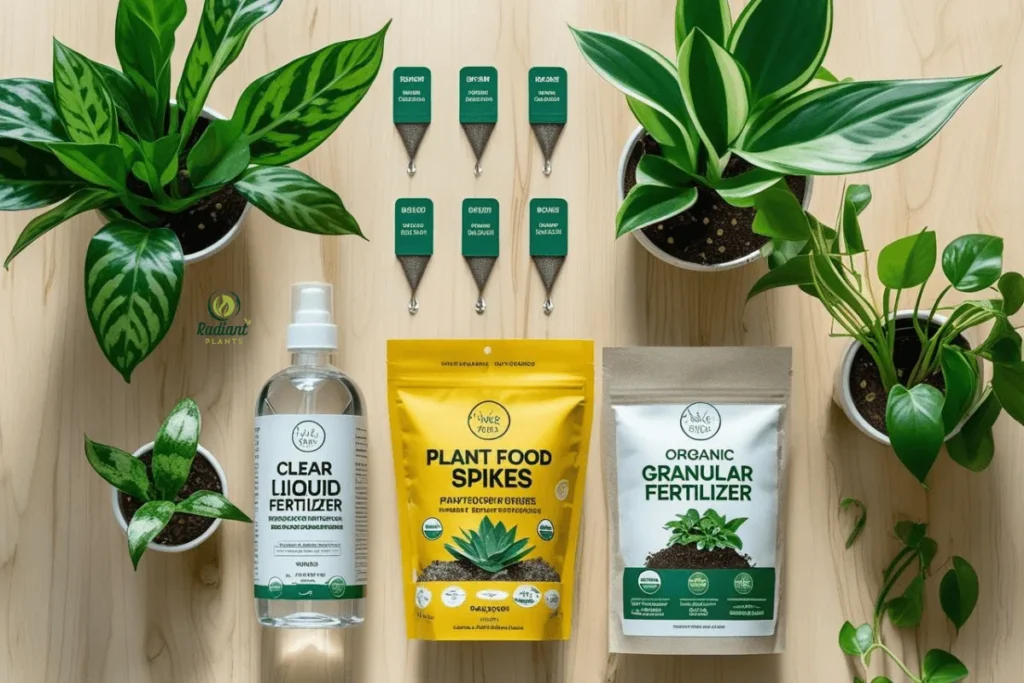
🪴 Snippet-style summary:
Choosing the best indoor plant fertilizer depends on your plant type and care routine. The right formula supports healthy growth, vibrant leaves, and strong roots.
Finding the right indoor plant fertilizer can make a world of difference in how your plants look and grow. Different plants have different nutrient needs—blooming flowers require more phosphorus, while leafy greens need more nitrogen. With so many fertilizer options on the market, it’s helpful to choose based on plant type, growth stage, and ease of use.
Below are some of the top-rated fertilizers categorized by plant type. These picks balance effectiveness, ease of use, and user reviews.
Top Products Based on Plant Type
🌿 Best for Foliage Plants (e.g., pothos, philodendron, peace lily):
- Miracle-Gro Indoor Plant Food (Liquid)
- Fast-acting and easy to mix
- Great for general foliage and frequent feeders
🌸 Best for Flowering Plants (e.g., African violets, begonias):
- Schultz African Violet Plus Plant Food
- High in phosphorus to encourage blooming
- Dropper tip makes it easy to apply while watering
🌵 Best for Succulents and Cacti:
- Espoma Organic Cactus! Liquid Fertilizer
- Low-nitrogen, gentle blend
- Organic and safe for monthly use
🌴 Best for Palms, Dracaena, and Large Tropicals:
- Jobe’s Organics Houseplant Spikes
- Slow-release spikes for hands-free feeding
- Ideal for larger potted plants with deeper roots
🧪 Best All-Purpose Fertilizer:
- Dyna-Gro Grow 7-9-5
- Complete nutrition with micronutrients
- Professional-grade, suitable for most houseplants
📊 Table: Best Indoor Plant Fertilizer Options
Product | NPK Ratio | Best For | Frequency | Notes |
|---|---|---|---|---|
Miracle-Gro Indoor Plant Food | 1-1-1 | Foliage plants | Every 1–2 weeks | Fast results, easy to mix |
Schultz African Violet Plant Food | 8-14-9 | Flowering plants | Every 7–14 days | Boosts blooms, easy applicator |
Espoma Organic Cactus! | 1-2-2 | Succulents & cacti | Monthly | Organic, low-salt formula |
Jobe’s Organics Houseplant Spikes | 4-4-4 | Large potted & tropical plants | Every 4–8 weeks | Slow-release, no mess |
Dyna-Gro Grow | 7-9-5 | All-purpose | Every 2 weeks | Complete nutrition including micronutrients |
Caption: Best Indoor Plant Fertilizer Options
Best Fertilizer For Indoor Plant – Happy Houseplants
📝 Tips for Choosing the Right Fertilizer
When selecting an indoor plant fertilizer, keep these points in mind:
- NPK Ratio Matters:
A balanced formula like 10-10-10 works for most foliage plants. For flowering types, look for higher phosphorus (middle number). Succulents prefer low-nitrogen blends. - Form & Convenience:
Liquid fertilizers offer fast results and flexibility. Spikes and granules are better for low-maintenance routines. - Organic vs. Synthetic:
Organic fertilizers are eco-friendly and promote long-term soil health, while synthetic ones act faster and are easier to control. - Watch for Special Needs:
Some plants (like orchids or carnivorous plants) may need particular blends—always check plant care tags or consult expert guides.
By matching the right indoor plant fertilizer to your plants, you ensure they get tailored nutrition throughout their growing cycle. The products listed above are great starting points for both beginners and seasoned plant parents alike.
Troubleshooting Fertilizer Problems
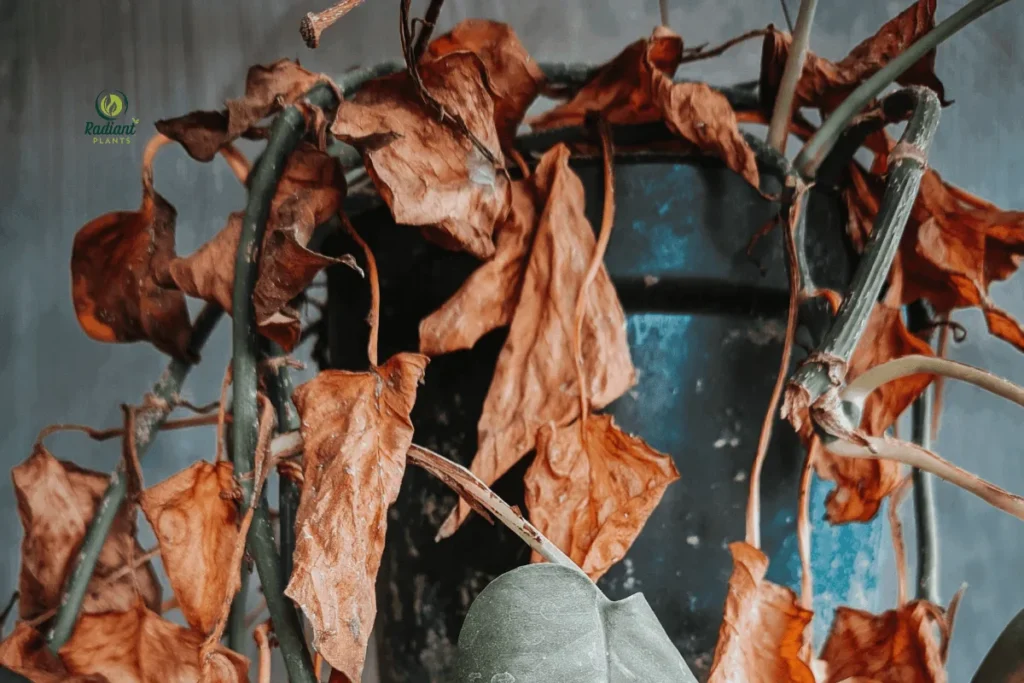
🪴 Snippet-style summary:
Fertilizer problems like leaf burn and white residue are often caused by overuse or buildup. Use the right indoor plant fertilizer carefully and act fast to fix mistakes.
Even when you’re using the right indoor plant fertilizer, things can go wrong. From yellowing leaves to crusty white soil, signs of trouble can appear quickly if nutrients are misapplied. Fertilizer-related issues are common among indoor gardeners, especially when plants are fed too frequently or in too high a concentration.
Let’s explore the most frequent symptoms and how to respond.
Leaf Burn, White Residue, and Other Issues
Many problems caused by fertilizer misuse are easy to spot—if you know what to look for.
🚩 Common Symptoms of Fertilizer Problems:
- Leaf Burn: Brown or scorched tips and edges, especially on new growth
- White Crust on Soil Surface: Salt buildup from frequent or heavy feeding
- Sudden Wilting: Roots damaged by too much fertilizer
- Stunted Growth: Nutrient imbalance can restrict development
- Unusual Leaf Discoloration: Yellowing, purple veins, or dark spots may signal toxicity
⚠️ These symptoms often appear days or even weeks after using indoor plant fertilizer. Always observe how your plant reacts after feeding.
Why These Issues Happen:
- Over-application or failure to dilute liquid fertilizer properly
- Fertilizing dry soil, which shocks the roots
- Using the wrong NPK ratio for the plant type
- Fertilizing too often, especially in dormant months
What to Do If You’ve Over-Fertilized
If you suspect you’ve overdone it with indoor plant fertilizer, don’t panic. Most cases are reversible with prompt action.
✅ Emergency Fixes for Over-Fertilization:
- Stop Fertilizing Immediately
- Put your feeding schedule on pause for 4–6 weeks.
- Flush the Soil
- Place the plant in the sink or tub and run clean, lukewarm water through the pot for 2–3 minutes.
- Allow water to drain completely. This helps remove excess salts.
- Remove White Crust
- Gently scrape off the top layer of affected soil (about ½ inch) and replace with fresh potting mix.
- Trim Damaged Leaves
- Cut off brown tips or scorched leaves to reduce stress and encourage new growth.
- Repot if Necessary
- In severe cases, replace the entire soil mix and repot the plant in a clean container.
📋 Quick Response Table: Fertilizer Troubleshooting
Problem | Cause | Fix |
|---|---|---|
Leaf burn | Over-concentration or dry soil | Flush soil, trim affected leaves |
Remove topsoil, flush, and reduce feeding | Salt buildup | Water deeply, and pause fertilizing |
Wilting after feeding | Root damage | Water deeply, and pause fertilizing |
Yellowing or stunted | Nutrient imbalance or overfeeding | Flush and resume with diluted mix |
No blooming | Wrong NPK (low phosphorus) | Switch to bloom-boosting formula |
💡 Tip: Always water your plant before applying fertilizer and follow label instructions precisely to avoid issues.
Proper use of indoor plant fertilizer comes down to balance. More isn’t always better, and skipping fertilizer when plants don’t need it is often safer than guessing. By watching your plant’s response and acting quickly when problems arise, you can maintain healthy, vibrant houseplants all year long.
FAQs About Indoor Plant Fertilizer
How often should I use indoor plant fertilizer?
Most indoor plants need fertilizer every 2–4 weeks during active growth in spring and summer. Reduce or stop feeding in fall and winter.
What is the best indoor plant fertilizer for beginners?
A balanced liquid fertilizer (like 10-10-10) is beginner-friendly. It’s easy to dilute and suitable for most houseplants.
Can indoor plant fertilizer burn leaves?
Yes. Over-fertilizing or applying to dry soil can cause leaf burn. Always dilute properly and water before feeding.
Do succulents need indoor plant fertilizer?
Yes, but only monthly during their growing season. Use a low-nitrogen fertilizer to avoid soft, weak growth.
Is organic indoor plant fertilizer better than synthetic?
Organic options release nutrients slowly and improve soil health. Synthetic fertilizers act faster but may cause a buildup if overused.
Indoor plant fertilizer is essential for keeping your houseplants healthy, vibrant, and growing strong. By understanding when and how to apply it—based on seasons, plant types, and product forms—you’ll avoid common mistakes like overfeeding or nutrient burn. Whether you choose liquid, granular, spikes, or organic blends, the key is consistent, mindful application.
Watch for signs your plant needs feeding, like yellowing leaves or slowed growth, and always follow product instructions closely. Different plants thrive on different routines: succulents need less frequent feeding, while blooming varieties benefit from phosphorus-rich formulas.
Don’t forget—less is often more. A balanced approach supports lush foliage, colorful blooms, and resilient roots year-round.

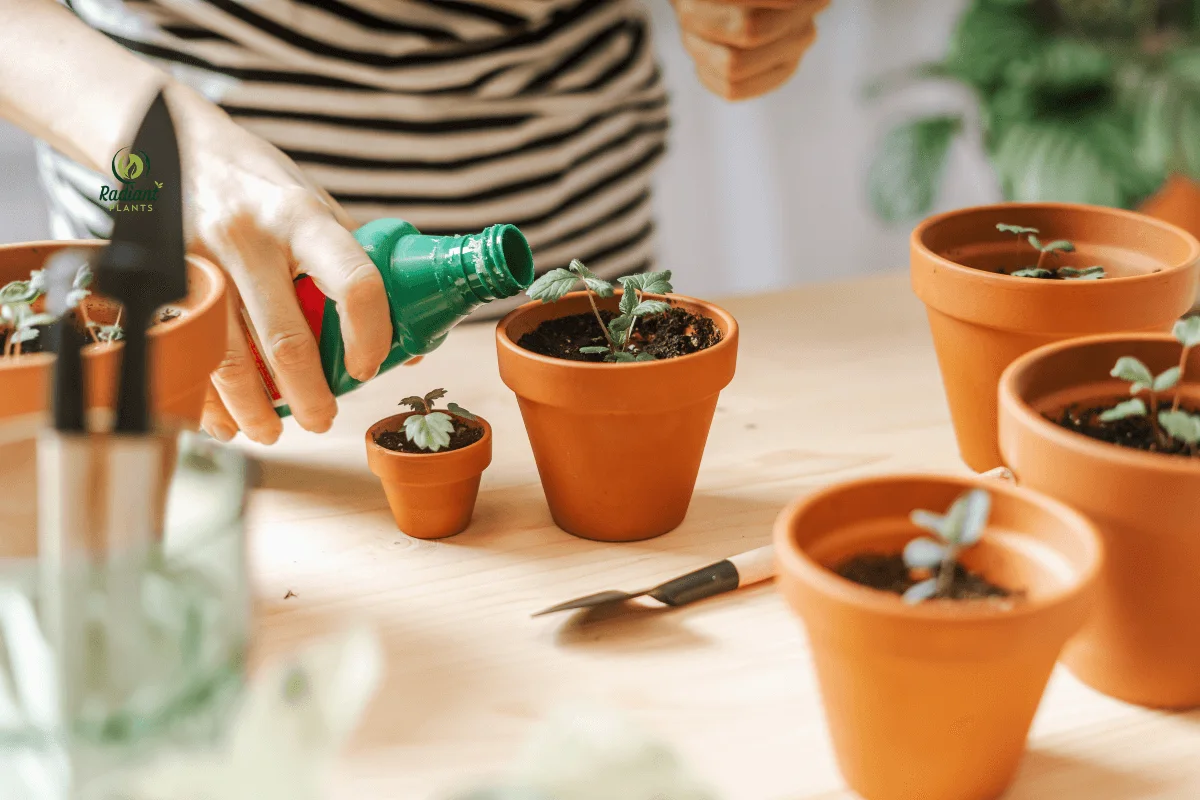
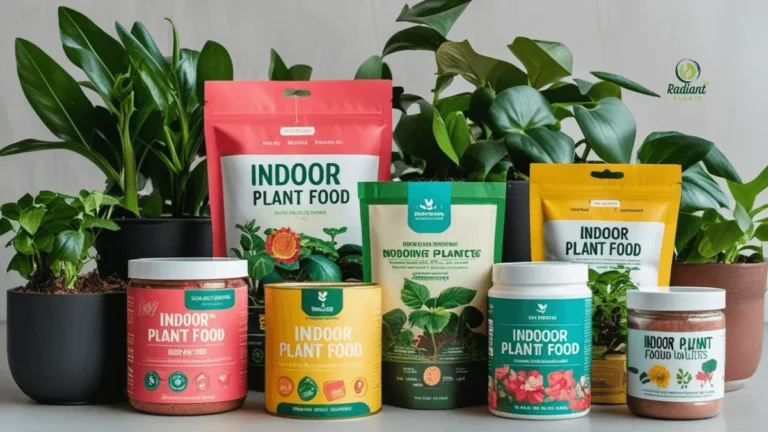
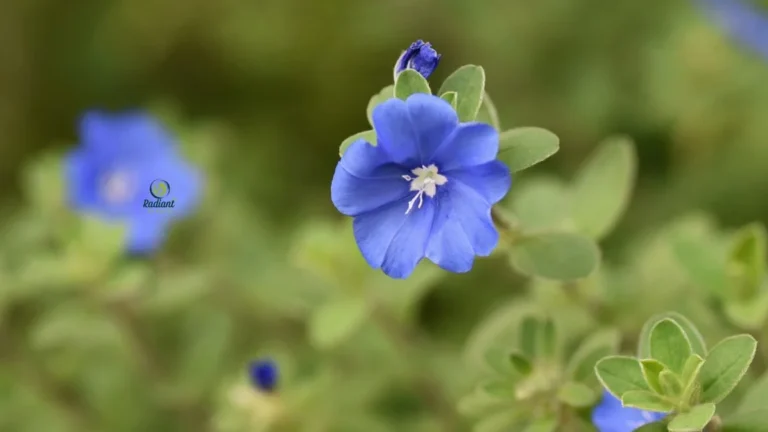
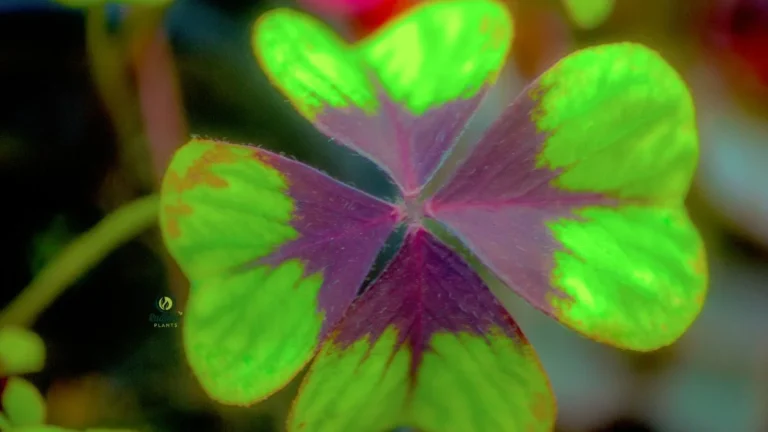
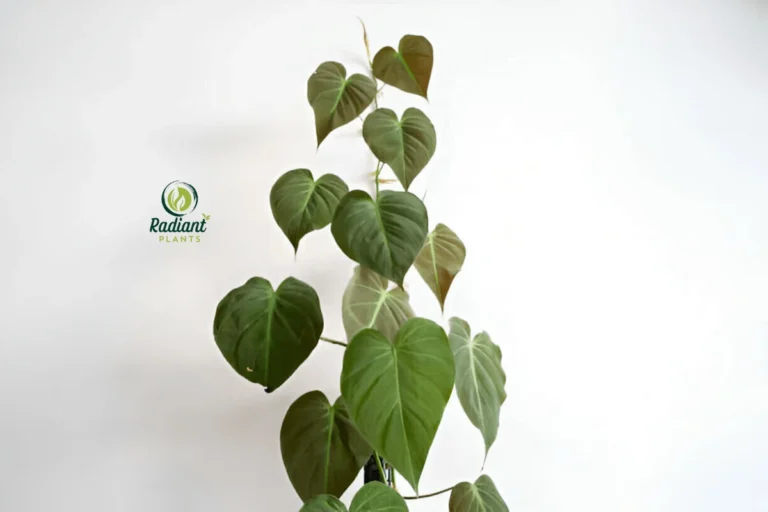
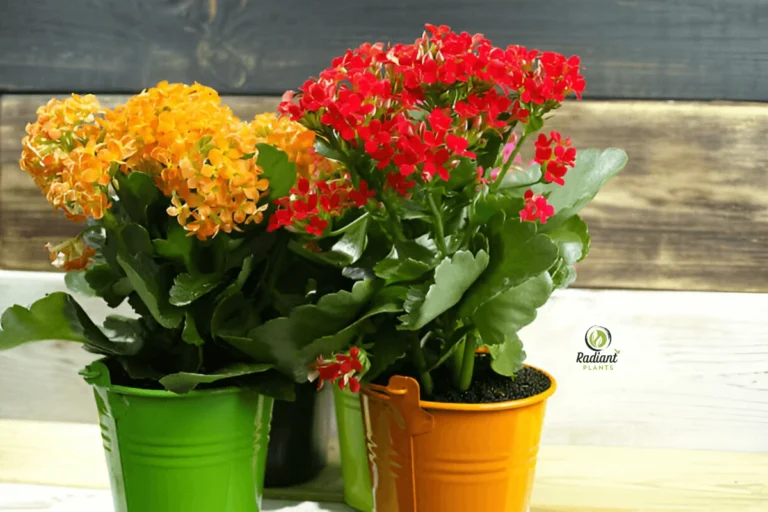
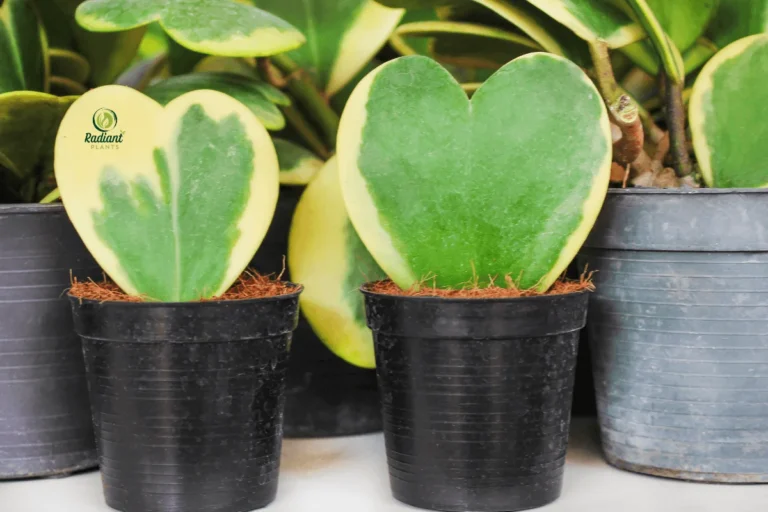
For the reason that the admin of this site is working, no uncertainty very quickly it will be renowned, due to its quality contents.
Thank you for the positive feedback! It’s great to hear that you appreciate the quality of the content. Maintaining high standards and providing valuable information is always the goal, and comments like yours make the effort worthwhile. I hope the site continues to be a useful resource for you and others who visit. If you have any suggestions for improvement or topics you’d like to see covered, feel free to share them!